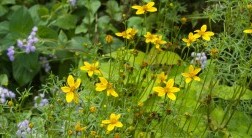Most suburbs look the same, right? Right! It's no mistake. It happened by design, or at least by benign intention. The urban-suburban landscapes of North America reflect a design tradition that has remained relatively constant since the middle 1940's. The scene looks something like this: emerald turf from lot line to lot line, a large shade tree off the corner of the house and a collection of sculpted or, worse, scalped shrubs lined up against the foundation.
The origins of this tradition can be traced in part to the early writings of influential landscape gardener Andrew Jackson Downing, who in 1865 was one of the first writers to promote a national landscape aesthetic to a wide audience. He set the stage for what has evolved into a traditional American front yard aesthetic.
Despite the influence of professional designers and design advocates, the prevailing standard has remained consistent. Like it or not, we've got a traditional front yard. Only by understanding and acknowledging this tradition can we begin to innovate in our front yards.
Inviolate Elements
1. An unobstructed view to the front of the house, from the front door and driveway out to the street. I call this the clear cone of view. Downing designed his 19th-century estates with the front of the house reserved for driveways and parking courts. The view was clear and there was no question about where to find the path to the front door. Modernist designers such as Tunnard, Eckbo and Church continued this tradition and later Agricultural Extension agents echoed the ideas with template designs for homeowners that labeled the front yard "public."
2. Manicured turf. At least 75% of our front yards is lawn. So prevalent was the lawn in the home landscape of England and America that Downing wrote, "The unrivaled beauty of the velvet lawn of England has passed into proverb." Later Thomas Church wrote "What is a good substitute for lawn? There is none—nothing that has its bright color in contrast to other garden greens or its texture or tactile qualities." A well-manicured lawn signifies care and thus indicates neighborliness and stewardship.
3. Foundation plantings. Serving originally to hide the foundations of houses suspended above ground without basements or cellars, foundation plantings continue as a front yard standard and direct your eye to the front door. They're usually isolated from other plantings that are positioned in the lawn away from the house.
4. One or more shade trees in the front of the house. Trees are used to provide shade, frame views and for decoration. For Downing they were "undoubtedly...one of the most beautiful objects in nature" and "among all the materials at our disposal for the embellishment of country residences, none are at once so highly ornamental, so indispensable, and so easily managed."
5. Street trees and median, especially in urban situations.
6. Flower gardens. They provide seasonal color in an otherwise mostly green landscape and afford homeowners direct contact with the soil. A well-tended bed of flowers signifies to neighbors that owners care about the look of their property and about the neighborhood. However the typical bed is usually isolated from other plantings in a sea of lawn, or perhaps around a tree.
Ecological Goals
Clearly the traditional front yard has a stranglehold on the American imagination. It is sacrosanct; in fact, even innovators like the National Wildlife Federation promote a backyard wildlife program that politely ignores the front yard. Problem is, the traditional front yard design promotes the paving of the American landscape with asphalt (for driveways and walkways) and turf, producing a landscape devoid of biodiversity. As the numbers of humans grow and more suburbs are created to house them, wild lands and wild creatures disappear.
Where is a warbler to go? If we are to maintain biodiversity outside parks, preserves and wilderness areas, we gardeners must take an active role. All suburban yards have a part to play. Through proper design, planting and plant choice, we can turn our yards-the front yard included-into wildlife havens that are beautiful to behold and acceptable to our neighbors. Summed over neighborhoods, these efforts can reconnect the fragmented landscape and heal the scars of decades of development.
To be truly innovative in front yards, we must improve and expand landscape structure, increase species diversity and work to amend entire neighborhoods so that we begin to re-create habitats.
Structure
In native plant communities, plants are arrayed in an organized structure creating both vertical and horizontal patterns. Vertical patterns are formed by layers of vegetation, from the tree canopy down to the wildflowers and ferns on the forest floor. In meadows and prairies the vertical patterns run from the tall grasses to ground-hugging violets. This structure can be re-created by gardeners to make an ecologically diverse and pleasing landscape. The various layers provide feeding and nesting habitats for wildlife. The more complex the structure, the more species a site can support.
In our gardens, horizontal patterns are disintegrated. We place a bed here, a tree there and some shrubs against the foundation. This is counter to the natural landscape. In nature, trees, shrubs and herbs form patterns in reponse to light, moisture and available space. This horizontal structure, like the vertical, is essential for habitat and creates attractive patterns in the garden.
Species Diversity
In a biological sense, the more different kinds of plants the better. Native forests, meadows and prairies are species rich, while our yards, featuring turf and a few shade trees, are not. To improve the ecology around our homes, we must approximate the natural diversity and plant more species. Avid gardeners seldom have trouble with numbers of plants, because we want to grow everything. But some non-native species are invasive and over time crowd out plants thus decreasing biodiversity. Native species and non-invasive exotics together can enhance the biodiversity of our yards.



